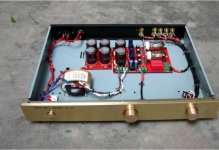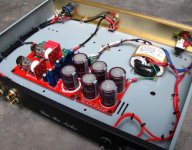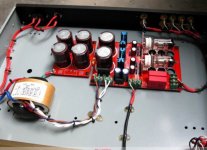Ian, all good info. Yes, I will do that. Original kit has only CRC filter for HV. I have already made it CRCRC. Will experiment further.
This is what I found on the web, somebody's commercial offering. Four inputs, selector, volume...and lots more filtering
This is what I found on the web, somebody's commercial offering. Four inputs, selector, volume...and lots more filtering
Attachments
1) see attached: page 276 hum block / ground lift
2) agree on the crcrcrc, don't go for clclc: the second choke will pick up enough hum from the mains transformer to negate it, clcrc works better. FWIW: Chokes have to be oriented just as much as an OPT.
2) agree on the crcrcrc, don't go for clclc: the second choke will pick up enough hum from the mains transformer to negate it, clcrc works better. FWIW: Chokes have to be oriented just as much as an OPT.
Attachments
PS Don't make the first C too large, smaller is better. The larger it is the sharper the charge pulse is that propagates through the system.
Shielding the tubes may help too although more difficult since they are on their side. You may want to consider a shield that goes on from the side, you get the idea at the second half of this page: https://www.surplussales.com/Tubes-Sock-Acc/TubeShields-2.html. (although those are for different tubes - you may be able to fashion the (TUA) 106-332-20 )
Shielding the tubes may help too although more difficult since they are on their side. You may want to consider a shield that goes on from the side, you get the idea at the second half of this page: https://www.surplussales.com/Tubes-Sock-Acc/TubeShields-2.html. (although those are for different tubes - you may be able to fashion the (TUA) 106-332-20 )
this does not seems to be pin compatibleDid you by chance test a 6N3? (5670)
I would, but they are expensive and shipping from japan is always includedconsider also the Japanese 6RHH1, 6RHH2, 6RHH2
Shielding a tube never helps against stray magnetic fields. I tried it with aluminium and with steel shield on the 1st stage of a phono preamplifier, no change with or without. The shield is meant against RF.Shielding the tubes may help too although more difficult since they are on their side.
You've got to use mu-metal, aluminium and plain steel are useless. Parts also can pick up magnetic fields, especially capacitors. Best is to start at the source and make sure that the power transformer is shielded. One mains transformer is not the same as another. It depends a lot on how they've been constructed: If they have a faraday shield and a copper shorting winding on the outside. Potting may, or may not, help but increases internal temperature and are ridiculously priced. Orientation is important, and a choke can pick up / create a lot of magnetic fields too. Both choke and mains transformers have to be kept far away from sensitive parts.Shielding a tube never helps against stray magnetic fields. I tried it with aluminium and with steel shield on the 1st stage of a phono preamplifier, no change with or without. The shield is meant against RF.
an update...since I still keep working on these, here is what I learned so far
When it comes to four types of tubes I used in this simple SSRP pre, 6N11 are the most linear and transparent, with lowest distortion. I have two pairs only, but that is enough to finish two pre in the final box. Two boxes were finished, one is in foamboard, has AC heater, and has lowest noise. Due to significant HV power upgrade with more CRC filtering. I will get to it later. This pre is in main system with Aleph J right now (tried F3, M2, few F1J...), all sounded great, but there is synergy with Aleph J. Sound is crystal clear, transparent, bells and triangles pure pleasure, yet the main characteristic different form solid state pre I tried is that sound is more musical, "liquid" is the best way to describe it.
Second pre is in blue aluminum box, working with F4, and its the same improvement, as it replaced BA3FA or J2 pre.
I have received 20 russian tubes 6N1P from ukraine, all working great but one. I measured all on vintage tube tester first, and discarded one. It was not showing "bad" but it was low in comparison to others. While measuring them, I selected two pairs and tested them in two remaining kits. While the distortion with 6N11 was ~0.018%, distortion with 6N1P is ~ 0.032%, this at high level, ~10dB below max soundcard signal. Still very clean sound, will finish with these tubes. Btw, compared to 6N1P Svetlana's I already had, exactly the same distortion, I think they are identical.
Here is what I learned so far about the hum. I tried on one kit about 5 different adapters to power the heaters. From 6VAC, to 12VDC, various sizes, normal trafo, switching brick, and so on. Switching supply was messy, so I did not used them. There was no difference between AC or DC adapters, because kits have 6.3 V regulator on the board. So it did not matter if I prefiltered the supply. I tried to lift the heater to ~50 volts DC tied to main HV power supply, but it had absolutely no effect. Biggest effect on overall hum was adding more filter stages to main HV power supply.
So I purchased lots of capacitors from parts express, they have sale or closeout deal on 440uF/200V caps, which I used in series with 1Mohm tied together. And they have 100uF/450V, both quiet cheap. Original filter after the rectifier is 200uF-150ohm-200uF filter. So only CRC. I removed the 150ohm on board and added external RCRCR and brought it back. This reduced hum to ~90dB below zero, the 60Hz peak is actually very low now, its 120Hz which is dominant, but above, the rest looks very clean. Above 1kHz, almost no noise, reaching -110dB. So adding more filtration steps was the way to go.
When it comes to 6N2P, they had high distortion to start with because ~250V power supply is too high, but even after reducing the voltage to ~140, the distortion was still higher then rest of the tubes. So I am not using these, even I have plenty.
When it comes to 6N6P, there was no significant improvement over 6N1P.
When it comes to four types of tubes I used in this simple SSRP pre, 6N11 are the most linear and transparent, with lowest distortion. I have two pairs only, but that is enough to finish two pre in the final box. Two boxes were finished, one is in foamboard, has AC heater, and has lowest noise. Due to significant HV power upgrade with more CRC filtering. I will get to it later. This pre is in main system with Aleph J right now (tried F3, M2, few F1J...), all sounded great, but there is synergy with Aleph J. Sound is crystal clear, transparent, bells and triangles pure pleasure, yet the main characteristic different form solid state pre I tried is that sound is more musical, "liquid" is the best way to describe it.
Second pre is in blue aluminum box, working with F4, and its the same improvement, as it replaced BA3FA or J2 pre.
I have received 20 russian tubes 6N1P from ukraine, all working great but one. I measured all on vintage tube tester first, and discarded one. It was not showing "bad" but it was low in comparison to others. While measuring them, I selected two pairs and tested them in two remaining kits. While the distortion with 6N11 was ~0.018%, distortion with 6N1P is ~ 0.032%, this at high level, ~10dB below max soundcard signal. Still very clean sound, will finish with these tubes. Btw, compared to 6N1P Svetlana's I already had, exactly the same distortion, I think they are identical.
Here is what I learned so far about the hum. I tried on one kit about 5 different adapters to power the heaters. From 6VAC, to 12VDC, various sizes, normal trafo, switching brick, and so on. Switching supply was messy, so I did not used them. There was no difference between AC or DC adapters, because kits have 6.3 V regulator on the board. So it did not matter if I prefiltered the supply. I tried to lift the heater to ~50 volts DC tied to main HV power supply, but it had absolutely no effect. Biggest effect on overall hum was adding more filter stages to main HV power supply.
So I purchased lots of capacitors from parts express, they have sale or closeout deal on 440uF/200V caps, which I used in series with 1Mohm tied together. And they have 100uF/450V, both quiet cheap. Original filter after the rectifier is 200uF-150ohm-200uF filter. So only CRC. I removed the 150ohm on board and added external RCRCR and brought it back. This reduced hum to ~90dB below zero, the 60Hz peak is actually very low now, its 120Hz which is dominant, but above, the rest looks very clean. Above 1kHz, almost no noise, reaching -110dB. So adding more filtration steps was the way to go.
When it comes to 6N2P, they had high distortion to start with because ~250V power supply is too high, but even after reducing the voltage to ~140, the distortion was still higher then rest of the tubes. So I am not using these, even I have plenty.
When it comes to 6N6P, there was no significant improvement over 6N1P.
Well, I do have 3d printer at work, so I use itThanks Ed,
A rather simple way of holding the pcbs instead of threaded standoffs, doublesided tape, etc - I wonder if there's any readily available similar product like radiator grills, air vents, etc - a very interesting idea ....
I go to thingiverse and if I see something useful, I will print it.
Most of the speakers or boxes for electronics from foamboard have some form of 3d printed board or grille, or knob or legs and so on...
I 3d printed even small speakers, but I am no expert in 3d design, I do not have computer fast enough to do cad design, or time for that.
oh, and I forgot one more thing, normally I use just twisted wires for audio signal. When I replaced these with normal shielded audio grade cable, hum was lowered few dB, clearly measurable
so in my case in these pre, twisted wires were inferior
others I noticed have different experience
so in my case in these pre, twisted wires were inferior
others I noticed have different experience
@adason - thank you for your work on this, it is very useful indeed.
Can I ask - you used exactly the same board and just swapped in 6N11 or 6N1P or the other tubes instead of 6N2? You didn't change other parts of the circuit (other than the added power supply filter/voltage)?
Can I ask - you used exactly the same board and just swapped in 6N11 or 6N1P or the other tubes instead of 6N2? You didn't change other parts of the circuit (other than the added power supply filter/voltage)?
- Home
- Amplifiers
- Tubes / Valves
- 6N1, 6N2, 6N11 (6DJ8) in pre?


